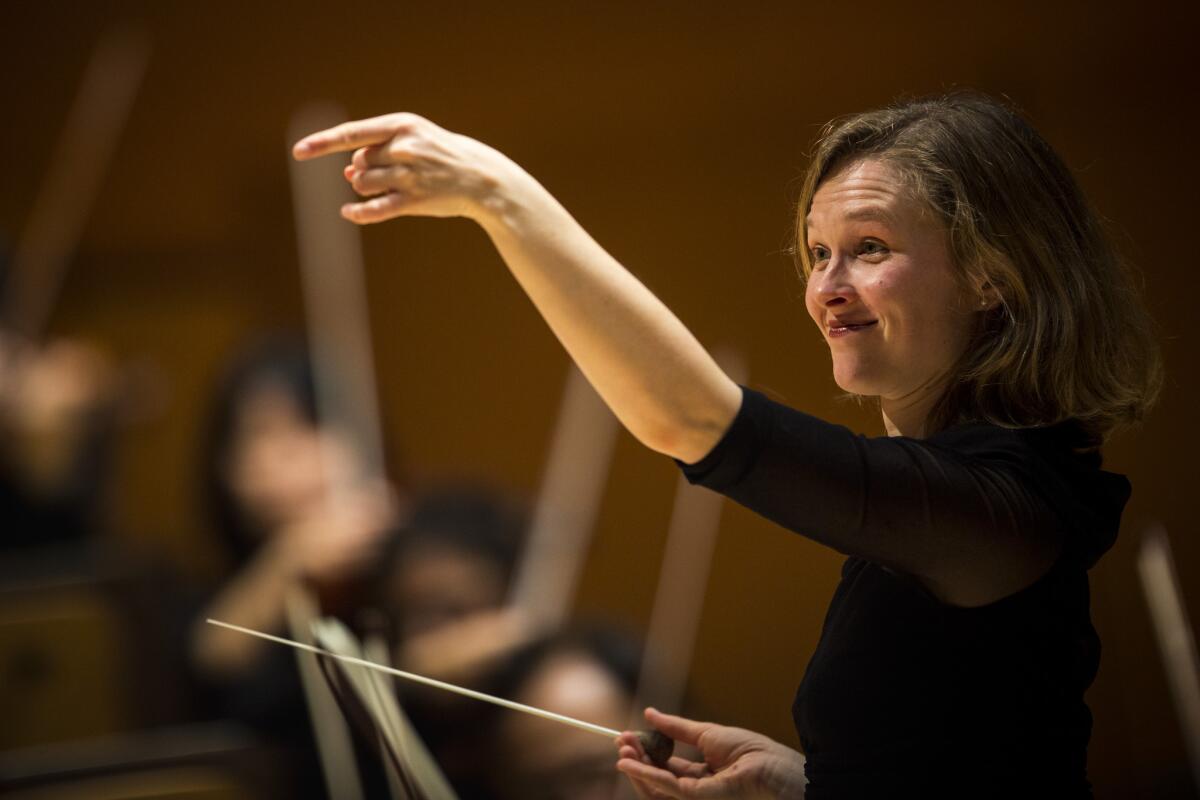Review: Mirga Grazinyte-Tyla takes the lead in an inspired women’s night with the L.A. Phil

Los Angeles Philharmonic assistant conductor Mirga Grazinyte-Tyla during a performance on Dec. 9, 2015.
- Share via
This is Mirga’s moment.
The biggest news in the conducting world this year has been Los Angeles Philharmonic assistant conductor Mirga Grazinyte-Tyla’s appointment as music director of the City of Birmingham Symphony. In the last quarter-century, this orchestra has become a steppingstone for young conductors to the top posts of the profession. The implications for a gifted 29-year-old woman are thrilling.
On Tuesday night, Grazinyte-Tyla, soon to become the L.A. Phil’s associate conductor, was in Walt Disney Concert Hall for the first time since the Birmingham announcement to lead her first Green Umbrella concert. It was, moreover, women’s night. Two works by women were commissioned for the occasion, and a third had its U.S. premiere. The twin-sister piano duo of Christina and Michelle Naughton came along for the ride.
See more of Entertainment’s top stories on Facebook >>
Grazinyte-Tyla’s participation was limited to conducting the L.A. Phil New Music Group in the first performance of Chaya Czernowin’s “Knights of the strange (Tutti)” and Clara Iannotta’s “Intent on Resurrection — Spring or Some Such Thing.” Both are composers who focus on sound for sound’s sake.
Like many other contemporary Italian composers, Iannotta put her effort into getting standard orchestral instruments to sound unlike themselves. Strings are scraped and altered with paper clips and knitting needles. Wind and brass players not only treat their instruments as percussion but also have access to megaphones and wine glasses. The piano is, of course, prepared John Cage-style.
It’s all pretty much percussion. Iannotta writes in her program note that she was inspired by the poetry of Dorothy Molloy, chronicling the destruction of her body through disease. Are these unearthly sounds then meant to be transformations of the awful, the way composers a century ago used dissonance to signal horror? With a hint of death, then transfiguration, the instruments become slightly less ghoulish by the end.
Czernowin, an Israeli who teaches at Harvard (where Iannotta is finishing a degree), also has a romantic idea behind her new work, which she dedicates to her son as he is about to go college. Again, the players in the ensemble, which featured a guest guitarist (Yaron Deutsch) and accordionist (Krassimir Sterev), rely on nontraditional effects from their instruments. At the end, musicians are asked to recite bits of text from a book Czernowin’s son wrote when he was 4, an awkward moment.
It’s not a compelling idea for a 21-minute ensemble work, but Czernowin’s ear for interesting textures, for creating instrumental phrases that operate like lungs inhaling and exhaling, and for the unexpected, saves her from her indulgent program note. She, moreover, had a friend in Grazinyte-Tyla, who seemed to lavish color and sparkle with each enthusiastic sweep of her arms.
The Naughtons’ gift is to sparkle into outright glitz. They have a fantastic technique, especially when it comes to rhythm and speed. They have a twins’ sense of telepathy, and their synchronization is downright acrobatic. But their showy style too often looks contrived for YouTube hits.
The sisters let a couple of dead men into the party, beginning the concert with a four-hand version of Conlon Nancarrow’s Sonatina, outrageously mechanical music they made cute. They began the second half with Lutoslawski’s “Variations on a Theme by Paganini,” playfully colorful music, which they made cute in exactly the same way.
They don’t make everything cute. On a new recording, “Visions,” released Friday, they instead colorlessly bang their way through Messiaen’s “Visions de L’Amen” and John Adams’ “Hallelujah Junction,” the latter presumably with Adams’ blessing, given the duo will premiere a new score by the composer in New York later this month.
So it was a surprise of the evening that Annie Gosfield’s “Refracted Reflections and Telepathic Static,” which was written for the Naughtons and ended the program, proved a delight. This time the sisters, who played the flashy 15-minute premiere impressively from memory, were terrific.
Gosfield, long a quirky voice on the downtown New York scene, zoned in on exactly what the Naughtons do best, which is mirror each other and produce dazzling cascades of percussive arpeggios. She had them going up and the down the keyboards merrily deconstructing jazz, Minimalist patterns and much else.
Inspired by mechanical instruments of old, Gosfield had the inspiration to cut all that piano tinsel with an electronic component (Matthew Davis ran the laptop) that incorporated samples of player pianos and mammoth orchestrions with their wheezing pipes. There were no farewells here and no disease, just sounds happily transformed, colliding and whooping it up.
Twitter: @markswed
More to Read
The biggest entertainment stories
Get our big stories about Hollywood, film, television, music, arts, culture and more right in your inbox as soon as they publish.
You may occasionally receive promotional content from the Los Angeles Times.











